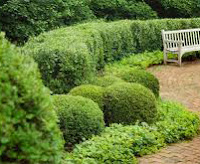Crabapple LandscapExperts suggest there are many reasons to include a hedge on the properties you manage.
Functions of Hedges
- Privacy: A hedge can be a security shield, act as screening, a barrier to traffic noise levels; hedges mark property lines, control human and animal passage ways
- Enclosure: Hedges create practical borders or dividers, separate areas using low shrubs as hedges, demarcate gardens, edge and define paths
- Organic fence-substitute: A hedge allows filtered wind to pass through unlike a solid fence, protects more delicate plants from cold weather or acts as a windbreak, and hedges are renewable resources, and can be environmentally beneficial as wildlife refuges
- Decorative: Hedges enhance the proportion and appearance of house and lawns, cost effective, long lasting, low maintenance
Evergreen Hedges are unchanging throughout the year, and can serve as tall privacy screens or low borders. They are often formally sheared, which means higher maintenance costs.
Tall Screening
- Holly
- Illicum
- Dwarf Wax Myrtle/Bayberry
- Camellia
- Tea Olive
- Boxwood
- Dwarf Holly, Box Holly
- Indian Hawthorn
- Glossy Abelia
- Pittosporum
Flowering and fruiting hedges are chosen for compact growth without pruning.
- Knockout Roses
- Forsythia
- Lilac
- Blueberry
- Azaleas
- Hydrangea
- Ornamental grasses
Specialty hedges can be chosen for their thorns. Some of these include
- Barberry
- Citrus
- Roses
- Quince
- Cotoneaster
Photo Credits thanks to Missouri Botanic Garden, Knockout Roses










